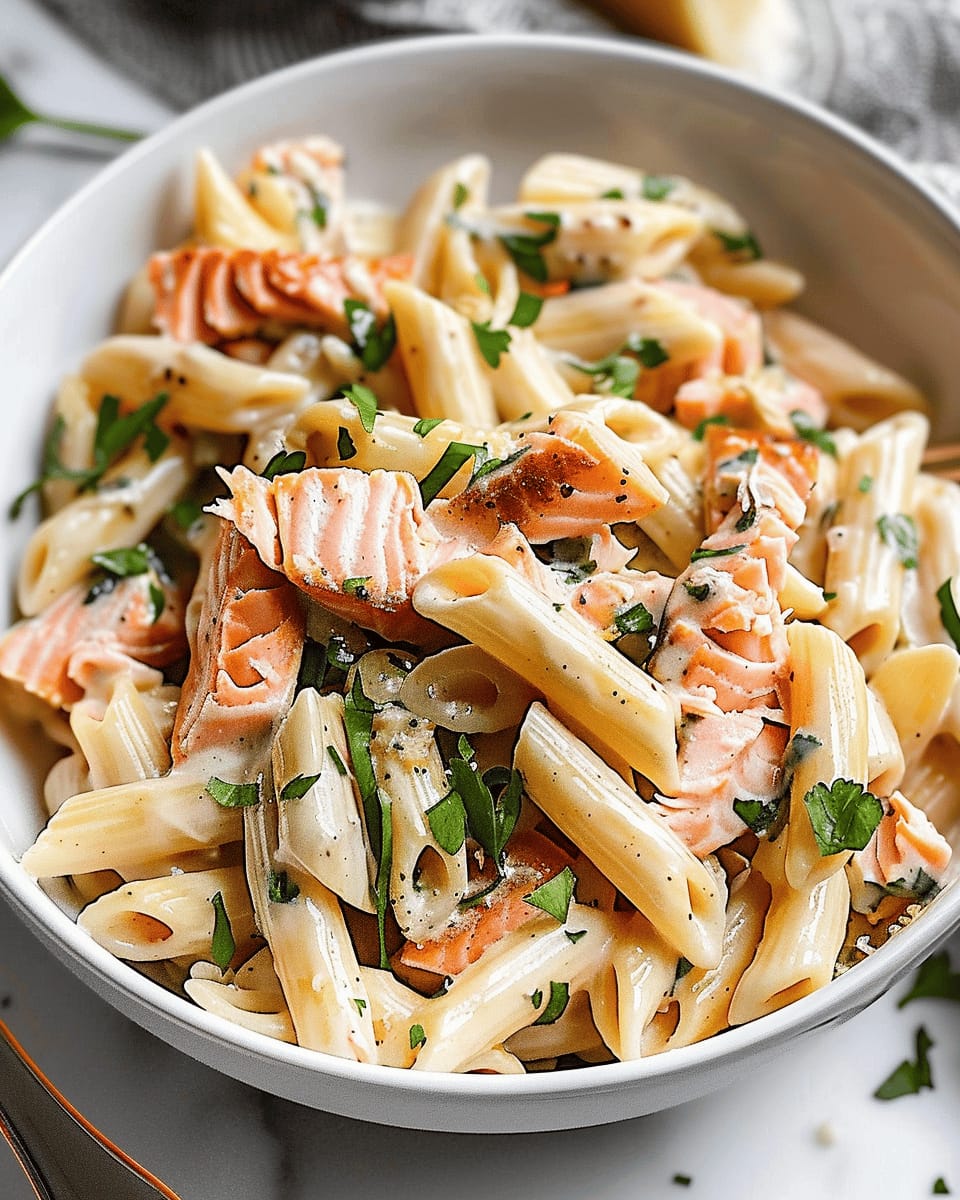Introduction
Salmon pasta is a delightful dish that combines the rich flavors of salmon with the comforting texture of pasta. This recipe is perfect for a quick weeknight dinner or a special occasion, as it brings together the freshness of herbs, the creaminess of sauce, and the nutrition of salmon. Whether you are a seafood lover or just looking to try something new, salmon pasta can be both satisfying and easy to prepare.
Detailed Ingredients with measures
Pasta: 8 ounces of fettuccine or your preferred pasta
Salmon: 2 fillets, about 6 ounces each
Olive Oil: 2 tablespoons
Garlic: 3 cloves, minced
Heavy Cream: 1 cup
Parmesan Cheese: 1/2 cup, grated
Lemon Juice: 1 tablespoon
Fresh Dill: 2 tablespoons, chopped
Salt: to taste
Pepper: to taste
Prep Time
The prep time for this salmon pasta recipe is approximately 10 minutes. This includes gathering all the ingredients and getting everything ready for cooking.
Cook Time, Total Time, Yield
The cook time is around 15 minutes. Therefore, the total time to prepare this dish from start to finish is about 25 minutes. This recipe yields 2 servings, making it perfect for a small dinner for two or for a cozy lunch.
Detailed Directions and Instructions
Prepare the Pasta
Boil a large pot of salted water and cook the pasta according to package instructions until al dente. Drain the pasta and set aside.
Cook the Salmon
In a large skillet, heat olive oil over medium-high heat. Season salmon fillets with salt, pepper, and lemon juice. Place the salmon skin-side down on the skillet and cook for about 4 minutes. Flip to the other side and cook for an additional 3-4 minutes until cooked through. Remove from the skillet and flake the salmon into large pieces.
Sauté the Vegetables
In the same skillet, add diced onion, minced garlic, and sliced bell peppers. Sauté for about 3-4 minutes until the vegetables are tender.
Add Cream and Cheese
Pour in heavy cream into the skillet with the vegetables, and bring to a simmer. Add Parmesan cheese and stir until melted and creamy.
Combine Pasta and Salmon
Add the drained pasta and flaked salmon to the skillet. Toss everything together until the pasta is well coated with the creamy sauce.
Season and Serve
Taste the pasta and adjust seasoning with more salt, pepper, or lemon juice if needed. Garnish with fresh herbs before serving.
Notes
Salmon Options
You can use fresh or smoked salmon for this recipe, depending on your preference.
Pasta Choice
Any pasta shape can be used, but fettuccine or penne works particularly well with the creamy sauce.
Vegetable Variations
Feel free to include other vegetables such as spinach, zucchini, or cherry tomatoes to enhance the dish.
Storage Instructions
Leftovers can be stored in an airtight container in the refrigerator for up to 2 days. Reheat gently on the stovetop or in the microwave.
Cook techniques
Sautéing
Sautéing is a cooking method that involves cooking food quickly in a small amount of oil or fat over relatively high heat. This technique is perfect for developing flavor while keeping ingredients tender.
Boiling
Boiling involves cooking food in water or broth at high temperatures. It’s ideal for quickly cooking pasta, ensuring it is al dente and ready to absorb sauces.
Emulsifying
Emulsifying is the technique of combining two ingredients that normally don’t mix, such as oil and water. This is often used for sauces to create a smooth, cohesive texture.
Seasoning
Seasoning is the process of adding flavor to your dish through various ingredients such as salt, herbs, and spices. Proper seasoning enhances the overall taste and brings out the natural flavors of the components.
FAQ
Can I use fresh salmon instead of canned salmon for the pasta?
Yes, fresh salmon can be used, but it will require additional cooking time to ensure it’s fully cooked and flaked properly.
What type of pasta is best for this recipe?
Any pasta will work, but fettuccine, penne, or linguine are great choices that complement the salmon well.
How can I make this dish gluten-free?
You can use gluten-free pasta and ensure that any other ingredients, such as sauces, are also gluten-free.
What can I substitute for cream in the sauce?
You can use alternatives like coconut milk, almond milk with a thickener, or a dairy-free cream substitute to achieve a similar creamy texture.
How long can leftovers be stored?
Leftovers can typically be stored in an airtight container in the refrigerator for up to 3 days.
Conclusion
The salmon pasta is not only a delightful dish for seafood lovers but also a versatile recipe that can be adjusted to suit various tastes. Its creamy texture combined with the freshness of salmon creates a harmonious balance that can be enjoyed on a casual weeknight or served at a special dinner. With a few simple ingredients, you can elevate your pasta experience and impress your guests with minimal effort.
More recipes suggestions and combination
Garlic Butter Shrimp Pasta
A rich and flavorful shrimp pasta cooked in garlic butter sauce, topped with fresh herbs for a touch of brightness.
Creamy Lemon Chicken Pasta
Enjoy tender pieces of chicken in a creamy lemon sauce paired with al dente pasta, perfect for a zesty twist.
Spicy Tuna Pasta
Combine canned tuna with a spicy tomato sauce and pasta for a quick, budget-friendly meal that’s packed with flavor.
Pesto Veggie Pasta
Toss your favorite vegetables and pasta in a vibrant basil pesto for a refreshing, meatless dinner option.
Alfredo Broccoli Pasta
A rich Alfredo sauce mixed with broccoli florets and pasta creates a creamy, comforting dish that’s easy to prepare.


Leave a Reply